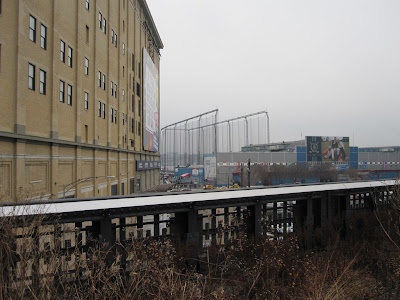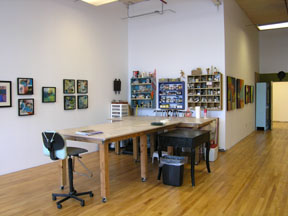By the way, if you don't know about the High Line, here's a link that will tell you all about it.
(CLICK PIX TO ENLARGE)
 |
| Anatsui's "Broken Bridge" as shown in Paris during the 2012 Triennial (from http://blogs.artinfo.com/artintheair/2012/06/25/el-anatsui-wraps-entire-building-facade-for-paris-triennial/) |
 |
| Night view of the Paris installation |
Now for the comparison of the New York work:
 |
| "Broken Bridge II" by El Anatsui at the High Line in New York (photo by Austin Kennedy from the High Line blog) |
Experimentation, Change and Adaptation
So, you will note that although BBII is made using the same elements as the original BB, it has an entirely different appearance. For one thing, that overhanging structure on the Paris building made a very strong top edge that confined (and I think literally overshadowed) Atatsui's piece. In the High Line work, unconstrained by architecture, he wanted to emphasize the sky, the buildings reflected in the mirror and the architectural shapes he saw. He speaks about that in this Art 21 video: Exclusive | El Anatsui: “Broken Bridge II”
I went to see Anatsui speak at the opening of his show "When I Last Wrote to You About Africa" at Wellesley College in April 2011. During his talk he stressed that he has a love of experimentation, change and adaptation and wants his work to reflect those considerations. Much of his work is modular so that it can be rearranged depending on where it's installed. He is not at all precious about his work and often takes it apart if it comes back to his studio to use in new pieces. He calls the salvaged parts "readymades." (You can read my blog post about his Wellesley show here.)
Remaking the Piece
Take a look at this compressed-time installation video from the High Line blog. The blacked out spot in the middle is Hurricane Sandy.
A Walk Along the High Line
I took a series of pictures as I walked along the High Line with my artist friends Binnie Birstein and Tamar Zinn. I thought that approaching this massive piece was a little surprising because it wasn't immediately apparent that it was there. Although it measures 37 feet high by 157 feet long, it's composed of mirrors and rusted metal that camouflage it in its surroundings--the mirrors blend in with the sky and the rust color blends in with aged brick nearly until you get right up to it. Have a look. (and click to enlarge the pix)
 |
 |
| This is the last photo of "Broken Bridge II." The rest of the photos give you the feeling of looking around at the architecture and plantings as you walk along. |
One further note, in one close-up of "Broken Bridge II" you can clearly see the rusty perforated metal in the piece. This metal was traditionally used for grating cassava (also called yuca, mogo, manioc, mandioca, and kamoteng kahoy - see the Wikipedia entry about its importance here)
And I'll leave you with this image of an earlier Anatsui work that used discarded cassava graters, "Crumbling Wall," 2000.






























3 comments:
Visual feast. Thanks for posting all these images Nancy. On this blizzardy night it is reassuring to think the earth will not be covered in white forever...
Thanks for your comment, Deborah. I'm glad you enjoyed it. It WAS nice to not see snow in the photos - a break from all that whiteness.
Love how you keep posting about Anatsui. Thanks.
Post a Comment